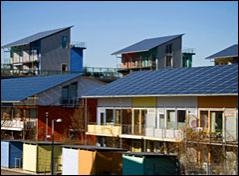The Fourth of July isn’t quite Earth Day but it’s becoming a favored holiday for companies and policymakers to declare energy independence, as was the case this past weekend.
Cypress Semiconductor, kicked things off when T.J. Rodgers, the company’s chief executive, declared at a press conference that the Silicon Valley chipmaker would go completely off the grid by 2015.
Not go carbon neutral — the favored strategy of many companies that buy carbon credits to supposedly offset their greenhouse gas emissions — but to actually cut the power cord. On Friday, Rodgers, one of the Valley’s more iconoclastic iconoclasts, unveiled the installation of three Bloom Energy Servers at the company’s San Jose campus.
Each of the fuel cells generates 100 kilowatts and, along with a massive rooftop solar array previously installed, supplies 75 percent of the corporate headquarters’ electricity, according to Cypress.
“We are three-fourths of the way toward achieving our goal using technology created right here in our own backyard, by the type of visionary minds that made Silicon Valley the center of innovation,” Rodgers, known for his Libertarian leanings, said in a statement.
Each Bloom box retails for between $700,000 and $800,000, but state and federal incentives halve the cost of the fuel cells. While Cypress may become energy independent, it won’t necessarily be zero emission. The fuel cells run on natural gas and do emit carbon, though they are able to operate in the green if they tap biogas made from cow manure or other biofuels.
Cypress, of course, incubated what has become one of the big players in solar energy, SunPower, which was spun out of the chipmaker in 2008.
Then on Saturday, President Obama did his part to stimulate solar energy and green jobs, announcing the awarding of a $1.45 billion loan guarantee to help finance the construction of a 250-megawatt solar trough power plant outside of Phoenix. The Solana project is being built by Abengoa Solar, the U.S. subsidiary of the Spanish renewable energy giant, and will feature six hours of thermal storage to allow the solar farm to keep generating electrons when the sun sets.
Obama also offered a $400 million loan guarantee to Abound Solar, a Colorado startup that makes thin-film solar modules. That will help the company build a facility in a defunct Chrysler automotive plant in Indiana.
But it wasn’t all puppies and sunshine on America’s birthday. As Jonathan Hiskes reported in Grist and I wrote in The New York Times over the weekend, the administration failed to prevent the Federal Housing Finance Agency from derailing the innovative Property Assessed Clean Energy, or PACE, program.
PACE lets homeowners repay the cost of installing solar panels or making energy efficiency home upgrades through a 20-year surcharge on their property tax bills. The loan is secured through a lien on the home, and like other property taxes, takes priority over the mortgage if a homeowner defaults.
That didn’t sit well with Fannie Mae and Freddie Mac. The government chartered mortgage giants said such liens could not supersede a mortgage. That paralyzed PACE programs nationwide and led some lenders to refuse to refinance mortgages on homes carrying energy liens unless the assessments were paid off first. (An analysis done by the California Attorney General’s office found little financial risk to Fannie and Freddie from PACE loans.)
Then on Tuesday, the housing agency, which oversees Fannie and Freddie, issued guidelines that effectively crush PACE unless Congress intervenes.
The Department of Energy even offered FHFA a two-year loan guarantee to cover any PACE-related mortgage losses Fannie and Freddie might suffer over the next two years, but this time there were no takers.



